Lessons from Amazon 'HQ2': Corporate Tax Incentives and Affordable Housing Need to be a Package Deal
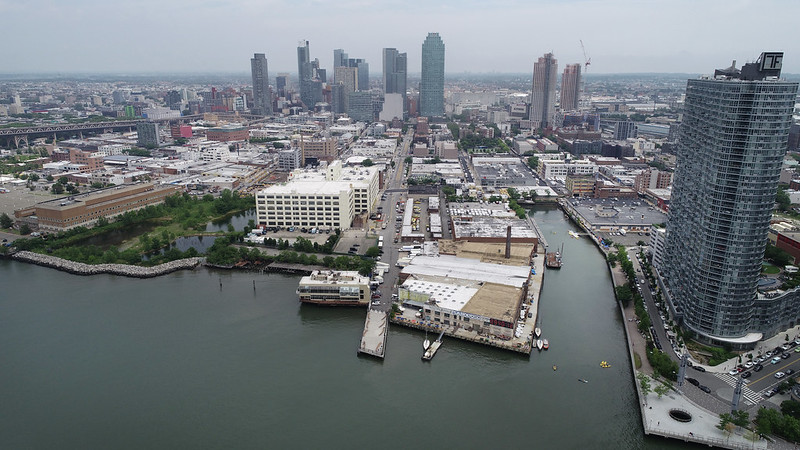
The planned Amazon site (photo: Kevin P. Coughlin/Governor's Office)
This week marks the one-year anniversary of Amazon’s contentious withdrawal from its Long Island City plans. Meanwhile, the construction of 'HQ2’ is making steady progress in Arlington County, Virginia, and residents are preparing to welcome thousands of new Amazon employees to their neighborhoods. With its close proximity to Washington D.C., established infrastructure, and educated workforce, Arlington County was a natural choice for Amazon and has been an attractive market for years, with median sales prices steadily increasing between 5-8% annually. Since the announcement, however, housing prices have spiked by 12.6%, and many residents are blaming ‘HQ2’ for throwing the housing market into a frenzy.
Given the fact that the State of Virginia pledged $750 million in subsidies to attract Amazon to Arlington County, it is fair to consider the possibility that taxpayers may have financed their own affordable housing crunch. The most obvious solution to this problem would be to build more housing - yet Arlington is subject to restrictive zoning laws that prohibit multi-family zoning in most of the county. Public officials in Arlington and beyond need to recognize that large corporate tax incentives must be paired with zoning and permitting policies that allow cities to respond to their housing supply and affordability gaps.
The ‘HQ2’ bidding process showed that municipalities looking to revitalize their communities are eager to offer tax incentives in exchange for the promise of new jobs – a competitive bidding practice that has become increasingly popular. Supporters claim that these incentives are a net positive for cities, with tax expenditures offset by the increased revenue generated by economic growth and related "spillover" effects. Yet this analysis ignores an important part of the equation: the increased strain on infrastructure, public services, and affordable housing.
In anticipation of Amazon’s arrival, Arlington County has started making infrastructure improvements such as updating its public transit systems and roadways. Yet, its to-do list fails to include the construction of new housing - largely because less than 12% of the city is zoned for multifamily development, like apartment buildings. Those restrictions stand in stark contrast to Long Island City, which by some estimates added almost 20,000 units of high-rise housing between 2010 and 2020, one of the highest absolute growth rates of any neighborhood in the nation.
Ironically, the very construction boom that made Long Island City such a competitive candidate for an Amazon campus may have spurred the opposition that ultimately torpedoed the deal. Still, local governments that offer tax incentives to attract large corporations would do well to mimic the LIC landscape by lifting the ban on housing types that can accommodate a growing, economically-diverse population.
That said, many recipients of economic development incentives are starting to grapple more seriously with the disruptive effects they have on local housing markets, which ultimately hamper their ability to attract talent. Tech giants like Google (which received a 22-year tax break) and Apple (a $10 million tax break) are blamed for making San Francisco one of the most expensive housing markets in the country. In 2019, both companies made headlines for their respective pledges to finance housing initiatives in California, with the hope of mitigating the housing shortages they contributed to creating. But unless cities reduce the regulatory barriers to creating more housing for a wide range of households, these generous donations will fall far short of their ambitious goals.
Given the political motivation for elected officials to create jobs for the cities and states they represent, it is safe to say that we can expect more of these incentives in this upcoming election cycle, notwithstanding the high-profile breakup between Amazon and New York. Research on the actual costs and benefits of these incentives is still inconclusive and highly contested. However, looking at Seattle, San Francisco, and now Arlington County, one thing is quite clear. Economic development incentives must be paired with more housing construction to foster diverse and inclusive cities.
***
Brittany Mazzurco Muscato is a Graduate Researcher at the NYU Furman Center and a Master of Public Administration candidate specializing in Public Policy Analysis at NYU’s Robert F. Wagner Graduate School of Public Service. On Twitter @bamazzur.
***
Have an op-ed idea or submission for Gotham Gazette? Email This email address is being protected from spambots. You need JavaScript enabled to view it.
Judicial Discretion Isn’t a Fix for Bail Reform; Bail Reform was the Answer to Judicial Discretion
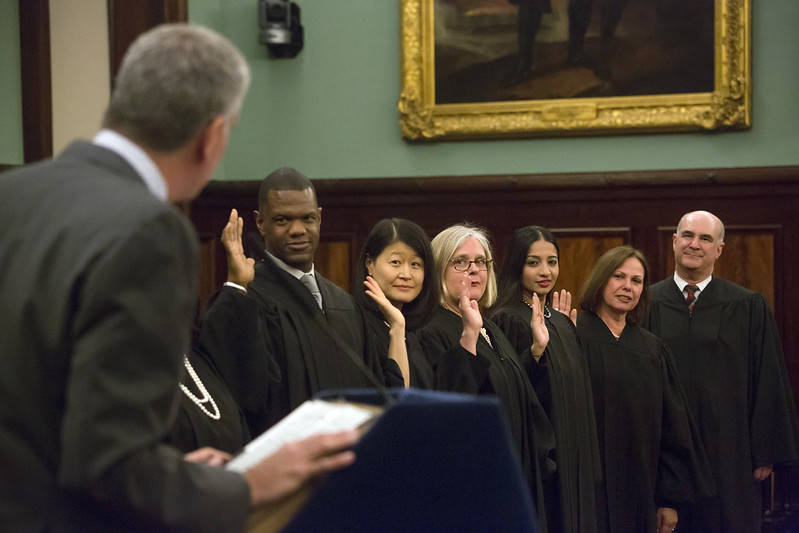
(photo: Ed Reed/Mayoral Photography Office)
As law enforcement and elected officials scream for a do-over regarding bail reform, they urge that judges should be given the discretion to remand people they believe to be dangerous. NYPD Commissioner Dermot Shea in a New York Times op-ed wrote, “We can trust New York State’s judges to use this discretion wisely and only for individuals who pose a real threat to the public or who continuously flout the justice system.” Shea’s boss, New York City Mayor Bill de Blasio, has been calling for giving judges discretion to decide a person’s dangerousness for years.
But the call for judicial discretion as a solution in search of a problem reveals that proponents are either ill-informed, naïve, or simply intent on returning to the racist and biased previous approach to bail.
By now, even those who argue for reforming bail reform agree that the system that had been in place for decades unconstitutionally and immorally punished people based on wealth. Governor Andrew Cuomo, as he signals a willingness to re-evaluate bail reforms, has said that “the system we had was discriminatory and biased.” That “system” was actually made up of individual judges.
Prior to January 1, 2020, it was common practice for judges of New York’s Criminal Courts to set bail that people without bank accounts couldn’t make. Stories are legion of people, almost exclusively people of color, held pretrial on Rikers Island, often on minor charges, because they lacked $500 or $1,000 to pay their way to freedom.
Judges were not required to set that bail. There was no law that mandated that kind of bail. Judges chose to do it.
In fact, 50 years ago the New York State Legislature reformed the bail laws to allow for other, less restrictive, forms of bail than cold hard cash. Alternative forms of bail like unsecured bonds that do not require any upfront cash payment have been on the books since 1970, but judges have steadfastly refused to utilize these statutorily authorized mechanisms despite repeated trainings, encouragement, and pleading.
Instead, in the exercise of their discretion, judges have chosen to incarcerate people based on wealth by using the harshest option available -- cash or insurance company bail bond – as a way of incarcerating poor people of color who are, after all, supposed to be presumed innocent. It is precisely this exercise of judicial discretion that had to be legislated out of existence.
While some law enforcement and elected officials warn of a bail reform apocalypse, it is critical to note that the judiciary, too, is clinging to the idea that money bail is sacrosanct. The revelations about the millions of people sent to Rikers Island because they couldn’t afford to pay their way to freedom are beyond dispute. There are countless stories of lost jobs, missed school, violence, and untold impact on physical and emotional well-being. Yet while there hasn’t even been any kind of publicly stated judicial remorse, let alone any mea culpas over the damage they inflicted, there are judges who bemoan bail reform and are trying desperately to return to the ways of the past.
Two judges, one from Nassau County and one from Albany County, chose to exercise their discretion by intentionally flouting the new law and setting cash bail that is now expressly forbidden by statute.
So, pardon those who cringe and rebel at the notion that bail reform needs a judicial discretion fix. If such a change is made and past is prologue, there will be an awful lot of people of color in pretrial detention after having been deemed to be “dangerous.” As the saying goes, fool me once, shame on thee; fool me twice, shame on me.
***
Steven Zeidman is a professor of law at CUNY School of Law. On Twitter @SteveZeidman.
***
Have an op-ed idea or submission for Gotham Gazette? Email This email address is being protected from spambots. You need JavaScript enabled to view it.
The Amazon Delivery We Still Need: Invest in Public Infrastructure, Not Corporate Welfare
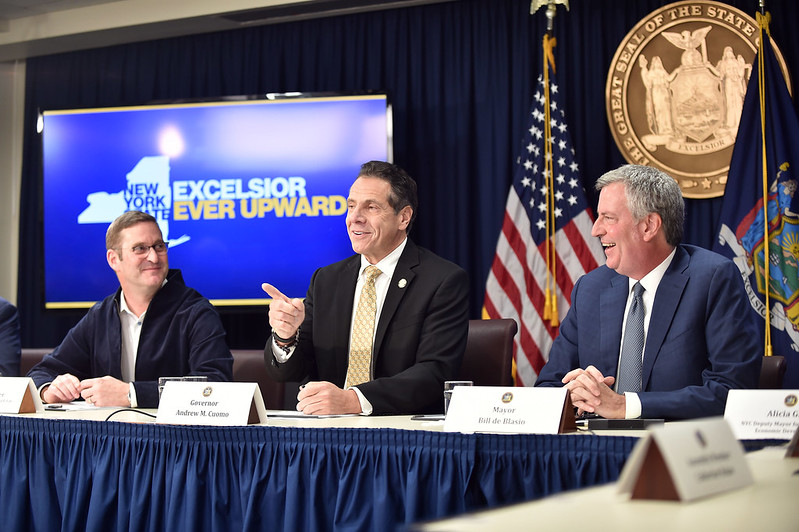
(photo: Kevin P. Coughlin/Office of Governor Andrew M. Cuomo)
This week marks the one-year anniversary of the cancellation of the Amazon ‘HQ2’ Queens deal, which presents an opportunity for New Yorkers to reflect. That these types of destructive corporate welfare deals are still possible and that Amazon is still coming to New York City, albeit in a smaller footprint with fewer public subsidies involved, shows there is a lot still to be discussed around what - and who - our government prioritizes.
With the quick success last year of community groups, unions, and local elected officials assembled to fight the deal, opponents didn’t get the chance to make the bigger argument against the failed economic development ideas ‘HQ2’ represents.
The ‘HQ2’ deal was bad for New York City. Amazon dangled the promise of 25,000 jobs -- without committing to it -- in order to get what it wanted, which was public land quickly, cheaply, and with minimal public oversight. Why would our elected officials give well over $3 billion in subsidies and land to one of the largest, most profitable corporations on earth for an office they were already going to build and could easily afford, without requiring Amazon to make tangible commitments to the public good?
Simply by asking this question, opponents were labeled as naive anti-development radicals. Nevermind that we are backed by 40 years of research linking runaway economic and social inequality in America to neoliberal policies that shower public wealth on corporations, fail to deliver promised public benefits, and take money away from investing in public services. Economists across the political spectrum from the American Prospect to the Cato Institute all oppose corporate welfare.
However, the establishment’s consensus on economic development limited the ‘HQ2’ debate to the terms of the deal after the fact, not whether the deal should be made in the first place. Many Democratic officials still lazily point to decontextualized polls that claim to show that ‘HQ2’ was “popular” as though they came close to explaining its consequences.
This mindset has been disastrous for our city. While HQ2 failed, Atlantic Yards, Hudson Yards (where Amazon is heading), and even Ground Zero have all followed the same neoliberal model -- give away public wealth to private profiteers in exchange for vanishingly small public benefits.
As glass towers, a new sports stadium, or a mall disguised as a transit hub rise around our city, critical public institutions like NYCHA, CUNY, and the MTA crumble. Yet the media largely gives cover to the establishment by treating these as separate universes divorced from the interconnected decisions that they make about where to invest our public wealth.
No one in our political establishment is called “radical” for giving billions of dollars of public money and land to developers, corporations, and billionaires while over 90,000 New Yorkers are unhoused. No one is called “naive” for still arguing, despite all empirical data, that subsidizing luxury development will trickle down. No one has paid a political price for when these expected public benefits don’t materialize.
Opponents of the Amazon ‘HQ2’ deal were also falsely accused of not having an alternative vision for growth. The real issue is what value “growth” has in the late capitalism era of rising income inequality, racial injustice, and climate disaster. Given these challenges, we must rethink our economic priorities. If the 2010s can be summed up as “move fast and break things” the 2020s should be “slow down and fix things.” The practical solution is obvious: public investment in public infrastructure.
We’ve done this successfully in the past. Look no further than Amazon’s decision to open an office in New York City without public assistance. It wasn’t attracted to New York City because of tax incentives (though it will benefit from the incentives Hudson Yards received). It was attracted because of generations of public investment -- the city’s density, lubricated by public transportation; its workforce, nurtured by public education and housing; and its amenities, grounded around public parks, libraries, and the arts. These upfront investments created the shared public wealth that attracts individual ambition and innovation.
Instead of investing our wealth in growing these public institutions, the political establishment has been co-opted by big developers, corporate monopolies, and extremist billionaires that funnel it out of our city into offshore bank accounts. Instead of fighting against economic inequality, racial injustice, and climate disaster, this system fuels all three. We can no longer tolerate this.
Amazon has exploited this system skillfully and ruthlessly, which is why many of us still protest its presence in our city a year later. I’m running for Congress -- to represent the district Amazon ‘HQ2’ was going to call home until we stopped it -- because we have the chance to hold this failed system up to public scrutiny and to hold our elected leaders responsible for giving away our public wealth for nothing. We might not be able to kick Amazon out of New York City altogether, but we can rid ourselves of this system along with the establishment that defends it, and replace it with one that works for every New Yorker.
***
Peter Harrison is a Democratic candidate for U.S. Congress (NY-12) and an adjunct lecturer at Baruch College. He lives in Stuyvesant Town. On Twitter @PeteHarrisonNYC.
***
Have an op-ed idea or submission for Gotham Gazette? Email This email address is being protected from spambots. You need JavaScript enabled to view it.
Surveillance and the City: Tracked Until Proven Innocent?
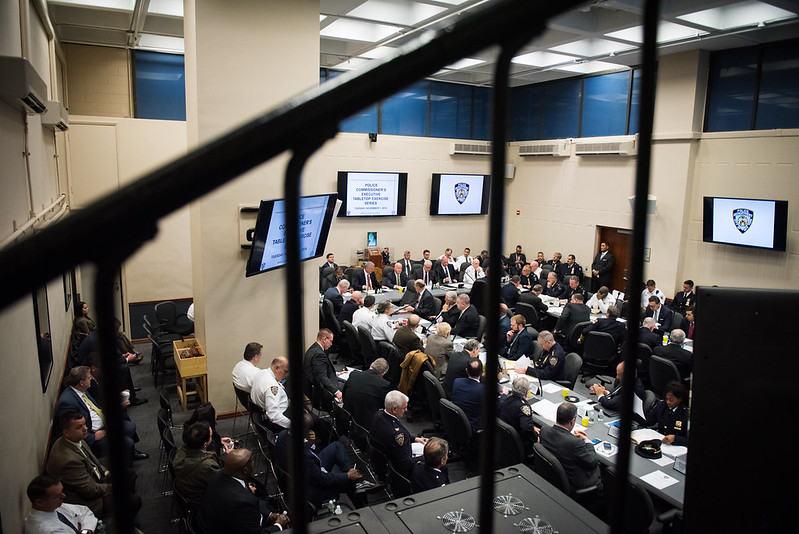
NYPD tabletop meeting (photo: Edwin J. Torres/ Mayoral Photography Office)
As advocates of mass incarceration slowly realize they are losing their grip on political power, they are flailing to find new strategies to undermine the state’s recent bail reforms. Under the media-driven, police union-inspired, fear campaign against reform, many advocates of the carceral state are pushing a new form of confinement: perpetual GPS monitoring. This techno-solutionism may sound like progress, but GPS monitoring carries the same presumption as cash bail: that some New Yorkers are guilty until proven innocent.
New York is not alone in seeing increasing pressure to replace physical incarceration with new and increasingly invasive forms of electronic monitoring. These surveillance systems can track every place you go, everything you say, and even those around you.
Forget the fact that the businesses cashing in on electronic monitoring have little evidence that it prevents recidivism. Forget the fact that the costly technology is often error prone. You are still left with the mindset of mass incarceration, the presumption that New Yorkers should be stripped of their rights and dignity simply for being charged with a crime.
Thankfully, City Hall has proven to be an unlikely ally in this fight. Don’t misunderstand, Mayor de Blasio hasn’t gone through some criminal justice reformation. The one-time Park Slope progressive didn’t rediscover the principles he seemingly shed on Gracie Mansion’s stoop. No, City Hall is delaying the expansion of electronic monitoring through bureaucratic delays and mismanagement.
Under New York’s recent reforms, private bail firms can no longer make a profit from renting electronic shackles. Instead, the City itself must take charge of the electronic monitoring program. This delay gives us a crucial window to push back against the wholesale tracking of New Yorkers waiting for their day in court.
The potential scale of electronic monitoring is staggering. In 2018, more than 77,000 people were arrested in New York City for felonies that qualify for electronic monitoring under the new state law. But that number is actually an undercount, since it doesn’t include the thousands arrested on qualifying misdemeanor charges. Yes, New York’s law is so broad that even those accused of certain misdemeanors might soon be forced to wear tracking devices while they await their next day in court.
To understand why that prospect is so daunting, you have to understand the power and perils of modern-day monitoring devices, which have become increasingly invasive and sophisticated. Some devices can turn wearers into walking wiretaps—recording themselves and anyone nearby. Devices can capture sensitive conversations with attorneys or doctors. Some jurisdictions even use this capability to record children.
And then there is the medical impact. It should surprise few that having an electronic device physically attached to your body can cause severe injuries. Complaints range from mild injuries, like bruises, hair loss, and headaches to more serious complications like electrical shocks, and impaired breathing and blood circulation. Many choose electronic monitoring rather than having to endure the horror of jail, but no New Yorker should be forced to choose between their health and freedom.
A new class of electronic monitoring devices spares users the injuries and indignities of traditional GPS anklets. Instead, some electronic monitoring firms install tracking software on users’ smart devices. These applications use the same location tracking that companies use to track phone users and target them with ads.
These products can be less stigmatizing than highly visible tracking devices, but they can have significant privacy and economic impacts. Many phone-based applications record users’ biometric information without disclosing how that data is saved or shared. Applications may access other information saved on users’ devices, and they can exhaust their data plan allowance and battery life. These impacts are quite substantial, especially for low-income individuals, and are a completely inappropriate way to punish New Yorkers who have not yet had their day in court.
Whatever form of electronic monitoring we use, the truth is that we won’t use it equally. Electronic monitoring is disproportionately targeted at low-income communities and communities of color. This should come as little surprise, since these are the exact same communities that bear the brunt of every aspect of the criminal justice system. Poorer New Yorkers are more likely to be arrested, more likely to be charged, and more likely to be subjected to invasive monitoring.
Electronic monitoring is particularly dangerous for undocumented New Yorkers. Despite our claims of being a “sanctuary city,” there is no law that would prevent Immigration and Customs Enforcement (ICE) or any other federal agency from getting a court order to force the city to provide users’ location history. This not only endangers undocumented defendants, but their neighbors, families, and faith communities. This is yet another reason why location tracking must not become the norm for those awaiting trial.
The bail reform backlash has shown that many New Yorkers are deeply uncomfortable with living up to the values we preach. But even some who support bail reform also buy into the false promise of electronic monitoring, propping up the broken logic of mass incarceration and the belief that poor defendants of color are entitled to less due process than their wealthy neighbors. We have to do better, and we have to continue to fight for a city where no New Yorker is tracked until proven innocent.
***
Albert Fox Cahn is the founder and executive director of The Surveillance Technology Oversight Project (S.T.O.P.) at the Urban Justice Center, a New York-based civil rights and privacy group, and a fellow at the Engelberg Center for Innovation Law & Policy at N.Y.U. School of Law. He writes the monthly "Surveillance and the City" column for Gotham Gazette. On Twitter @FoxCahn & @STOPspyingNY.
***
Have an op-ed idea or submission for Gotham Gazette? Email This email address is being protected from spambots. You need JavaScript enabled to view it.
New York’s Wrongly Open Skies
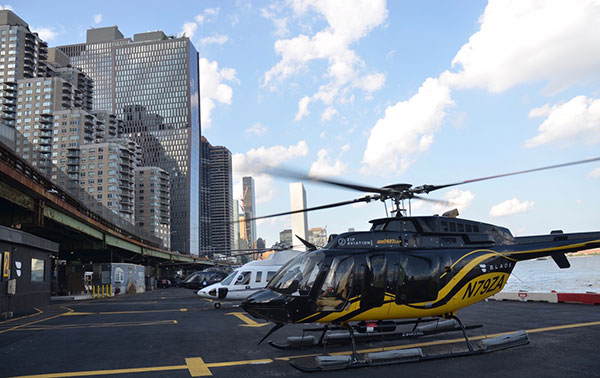
helicopters in Manhattan (photo: Julia Vitullo-Martin)
Helicopter crashes in the skies of New York City — two in 2019 —temporarily bring renewed attention to the odd situation by which hundreds of vehicles weighing up to 12,000 pounds each fly low every day over the country’s densest city, a city that was attacked from the air in 2001.
Precisely how many flights there are, by whom, and for what purpose are secrets kept by New York City’s Economic Development Corporation, which oversees three heliports on behalf of their owner, New York City.
Manhattan Borough President Gale Brewer says that complaints about helicopter noise and pollution are constant, and have been for years. And even though we are all now subject to time-consuming and sometimes intrusive searches to board planes at airports, passengers and pilots on helicopters undergo only the most cursory security procedures.
The recent helicopter crash that killed Kobe Bryant and eight others occurred north of Los Angeles, on the other side of the country, yet the catastrophe holds several sobering parallels for New York.
Dangerous Terrain
Burdened with the nation’s busiest airspaces, both L.A. and New York City also have dangerous, sky-high terrain that helicopters must avoid. LA has mountains, New York has skyscrapers.
Bryant’s helicopter lacked a Terrain Awareness and Warning System (TAWS), as do many, perhaps most, helicopters flying over New York. Even though the National Transportation Safety Board (NTSB) has long urged that warning systems be mandated, the Federal Aviation Administration (FAA), the federal agency regulating helicopters, has resisted, saying that because helicopters fly so close to buildings a TAWS would produce too many false alarms. Both L.A. and New York are also subject to the thick marine layer and dense fog that were factors in the Bryant crash.
Frequent Commuting
Bryant was commuting by helicopter, a practice that is increasingly common in New York, and for the same set of reasons: clogged and unpleasant ground transportation.
As the LA Times noted recently, the customer base for heli-commuting “skews rich, famous and traffic-averse.” Private entrepreneurs have eagerly responded to demand. As Jeff Holden, Uber’s Chief Product Officer, said, “So far we’ve been focused on ground-based transportation, but then we asked ourselves: Why can’t we fly today? Why can’t we take to the air? It’s not a matter of if, but when,” which was July of last year.
And not just Uber. “There isn’t gridlock in the sky,” says Rob Wiesenthal, the founder and chief executive of Blade, the vanguard company flying luxurious helicopters to the airports, the Hamptons, and Nantucket told the Wall Street Journal. Voom CEO Clément Monnet claims to be improving “people’s lives by giving them access to the air.”
Lightly Regulated
The twin-engine Sikorsky S-76B, a familiar vehicle to sky-watching New Yorkers who can see the big white helis regularly power across Manhattan, is owned by charter company Island Express Helicopters. Like all L.A.-based charter companies, Island’s FAA operating certification limits its pilots to flying under visual flight rules, which require a half-mile of daytime visibility and the ability to see the ground. The company lacked certification for its pilots to fly with instruments, the system for operating in fog or clouds. But the FAA seldom penalizes this violation, letting helicopter companies operate on a self-regulatory basis.
And it’s worth remembering that the above factors were also central to New York’s June 10, 2019 horror when a helicopter burst into flames after smashing into the fog-shrouded roof of a 7th Avenue office building. That pilot was also not authorized to fly using only instruments. He shouldn’t have been flying at all in the rainstorm.
Worse, the helicopter company whose March 2018 doors-off flight crashed into the East River, killing five tourists, is still flying, unimpeded — unchallenged even — by federal regulators. A report by the National Transportation Safety Board in mid-December of this year placed the blame for the accident on the company, which had bypassed strict standards for sightseeing tours by falsely categorizing its flights as photographic in purpose, which has far looser regulations. And it had installed deficient harnesses, said the NTSB, that locked each tourist in place, pinning them helplessly as the helicopter turned over in the frigid water.
There’s a fundamental reason New Yorkers should be concerned about what’s happening in the skies of Los Angeles: like all American cities, neither L.A. nor New York controls its own skies. Skies are the purview of the federal government, which might in itself be OK, except that regarding helicopters and other low-flying aircraft the federal government has simultaneously asserted its authority and refused to regulate on any significant level. If any kind of serious reform — and that includes serious regulation — is to come to the helicopter industry it will have to begin in the big cities.
Yet despite a few rhetorical flourishes from Mayor Bill de Blasio denouncing commercial helicopter flights, City Hall has taken no recent steps to curtail flights.
Basically, anyone can fly through New York skies unless the federal government intervenes and says they can’t. But the federal government now and pretty much forever has been loath to restrict flights — even in the aftermath of 9/11. And even the city’s occasional attempts to control quality-of-life issues like noise and pollution have been restricted, originally by Supreme Court Justice Sonia Sotomayor in 1997, when she was a district judge.
In National Helicopter v City of New York, she permanently enjoined the city from imposing a mandatory 47% reduction in helicopter operations at the East 34th Street Heliport, designating tourist sightseeing routes, excluding Sikorsky S-58Ts from sightseeing flights, and mandating that all helicopters be marked for identification. A federal appellate court subsequently allowed the city to restrict operations, but permitted the ban on markings to stand.
This alone is a huge issue, and one that Borough President Brewer has been fighting for years. Federal regulations require that helicopters be individually identified, but the city (and Brewer) wanted the identification to be visible, painted in large digits — much like NYPD patrol cars or MTA buses — so that New Yorkers would know what was flying above them, hovering over Shakespeare in the Park performances or racing up and down West End Avenue on Sunday mornings.
Are these flights for tourism? Corporate commuting? Paparazzo? Government? Media? Police and emergency? We can’t know. Central Park, so precious to New Yorkers as a peaceful haven, is to the FAA a helicopter corridor. The FAA’s Central Park Route runs from West 72nd Street to the northern tip of Roosevelt Island, thus the many complaints Brewer’s office receives from Upper West and Upper East Siders.
What’s to be done?
The simplest, most direct solution would be for the FAA to issue Temporary Flight Restrictions forbidding flights over New York City, as it has done for Disneyland, of all places. But this is unlikely to happen. The FAA is what political scientists call a “clientele agency,” meaning their main mission is to protect rather than regulate the clientele industry.
Led by Rep. Jerry Nadler, New York’s congressional delegation has repeatedly introduced legislation to ban nonessential flights over New York City, the most recent being the Helicopter Safety Act. But what is nonessential? The FAA has repeatedly ruled that any transportation use, including commuting, is valid, and under the bill helicopter flights deemed essential would still be allowed, including law enforcement, emergency response, disaster response, medical services, or “for the public interest,” which is undefined.
It’s possible that even if Nadler’s bill passes, New York will be left with tens of thousands of flights deemed essential.
Technology can help. Flight tracking services, like FlightRadar24, provide real-time data on thousands of flights around the world, but also in your neighborhood, telling you which aircraft models are flying, as well as their origin and destination. At peak hours, the FlightRadar24 map of Manhattan looks like it’s infested with insects, as the tiny helicopter emoji crowd one another all over the borough.
The app is not yet sophisticated enough to catch every flight, especially for the low-flying aircraft that especially distress New Yorkers. But you’ll often see helis on the app hovering over city parks, monuments, and waterfront areas where taxpayers have invested billions of dollars. As former New York City Parks Commissioner Adrian Benepe says, “Taxpayer investment in parks is being ruthlessly undermined by the ongoing blight of helicopter flights.”
The first step in reform is to get the information: how many flights, by whom, in what aircraft models, for what purpose? What are their routes? How low are they flying?
NYCEDC keeps some generic data, which it publishes reluctantly and rarely, on its three city-owned heliports. But no agency releases data on the thousands of flights coming in from outside New York City’s borders, mainly New Jersey and Long Island, but increasingly upstate New York and New England. And if the on-demand flight services get their way, soon there will be more flights from more distant points.
Government agencies refuse to release their data, but a citizens’ brigade of heli watchers, armed with flight tracking apps, could provide enough of the data to demonstrate the extent and precise geographic locations of the issues.
***
Julia Vitullo-Martin is a writer and planner. On Twitter @JuliaManhattan.
***
Have an op-ed idea or submission for Gotham Gazette? Email This email address is being protected from spambots. You need JavaScript enabled to view it.
Will the MTA Really Turn Its Back on Disabled New Yorkers Yet Again?
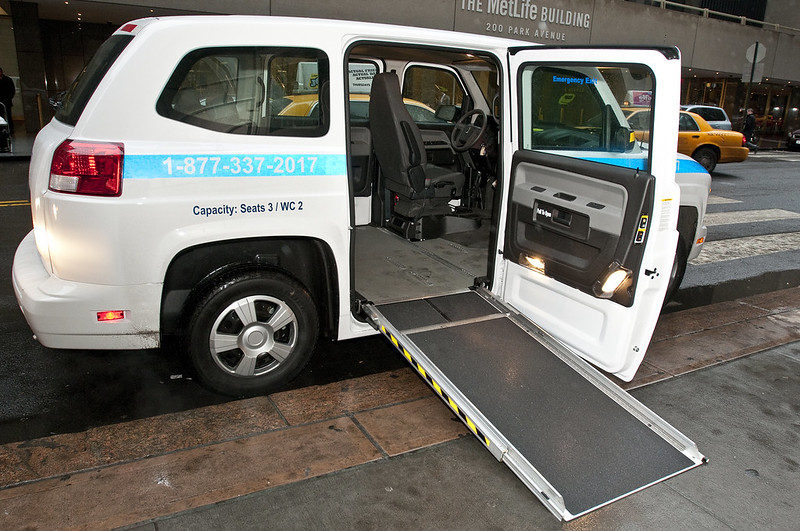
(photo: Patrick Cashin/Metropolitan Transportation Authority)
Although accessibility is a hot topic of late, is government truly willing to partner in the multifaceted effort required to increase positive outcomes and general quality of life for our city’s residents and visitors with disabilities?
People seem to enjoy theorizing about its necessity and how long overdue universal design has been, but once the discussion reaches implementation, the ideals suddenly are not as indispensable as they once were.
I am a Brooklyn-based blind New Yorker who has been using Access-A-Ride since 2003. In 2017 I applied for and was selected to participate in the On-Demand E-Hail Pilot Program with Access-A-Ride and the city’s Taxi and Limousine Commission. In total, there are 1,200 users in the program who were all selected from a waiting list.
As the pilot program is now set to be severely restricted in the coming months, I am concerned with the future of Access-A-Ride service and the rights of our city’s residents with disabilities who cannot ride the subways and/or buses.
This program has greatly enhanced my level of independence and productivity as a professional person who is blind and juggles two jobs. Putting a cap on the number of rides I can utilize with on-demand service is the equivalent of putting a cap on my potential success as a blind person.
Traditional Access-A-Ride service does not give an individual with a disability the same level of autonomy and access to opportunity that straphangers typically enjoy. Having to schedule trips before 5 p.m. a day or two in advance, enduring the number of late pickups and the often-circuitous rides of the five boroughs made it very frustrating to use at best.
Traditional carriers have been making an exorbitant amount of money at over $80 per trip. In comparison, the on-demand e-hail trips average $36 per trip for a superior service at less than half the cost, allowing disabled citizens to live our lives with some autonomy and dignity. Despite multiple audits, exposed inefficiencies, and ties to unsavory crime elements over the years, the MTA still thinks it viable to utilize traditional Access-A-Ride carriers who are more than willing to overcharge to provide horrendous service for people with no other means of transport.
Although all of these issues were solved in one fell swoop with the inception of the e-hail program, the MTA has announced that due to the increased ridership (based on a biased user sample) use of on-demand service will be restricted to 16 rides per month with a subsidized cap of $15 per ride. I wonder if MTA Board members, Access-A-Ride management, and Governor Cuomo, who effectively runs the MTA, understand that disabled folks are not porcelain dolls, just living our lives on a glass shelf somewhere. Paratransit costs are projected to surpass $600 million this year; is that massive sum being invested wisely? Is there any awareness as to why this amount of taxpayer dollars is being invested in a necessary resource that is supposed to level the playing field? Or to some at the MTA, might the paratransit discussion be analogous to an unpleasant mundane task such as figuring out trash removal?
Plans for more elevators, improved wayfinding, and tactile navigation strips in the subway are all welcomed enhancements when they do arrive, but Access-A-Ride service must evolve as well.
We must all better understand a difficult and frustrating situation and identify and pursue the steps to fix it. We need to raise awareness, arrive at equitable solutions, and hold the MTA accountable. If we are properly enabled, those of us with blindness and other disabilities can and will contribute so much more to our city.
Access-A-Ride must be a key piece of the equation. The MTA claims increasing ridership makes the on-demand pilot unsustainable, but that is a sign of success and we should embrace the fact that this service is needed, and that it allows New Yorkers with disabilities to live fuller lives and contribute to our city’s fabric in so many ways. Not only do individuals with disabilities contribute socially, helping to raise awareness and promoting tolerant and inclusive attitudes, we are making economic contributions as viable workers and consumers.
The Access-A-Ride pilot program has been life-changing for many of us who contend with a disability. It has enabled me to accept a promotion as an itinerant supervisor of teachers of the blind/visually impaired. My main office is in Manhattan, while I supervise teachers in Staten Island, Queens, and Brooklyn. Without the autonomy and flexibility that on-demand Access-A-Ride service facilitates, I would not be able to competently perform my job at the highly proficient and efficient level that allows me to professionally compete with my non-disabled colleagues, as traditional Access-A-Ride service makes it impossible to move around in a reasonably efficient and timely manner.
Governor Cuomo and MTA Chair/CEO Foye, I ask you to consider how you would compensate if you had newly found autonomy and mobility and then they were going to be restricted; how would you deal with all the issues that I am now confronted with?
My fellow taxpayers, this is a civil rights issue, as our governor and the MTA have clearly decided that disabled citizens who need to utilize Access-A-Ride are not entitled to the same rights, autonomy, and access to opportunity as non-disabled citizens. And the reason? Because they’ve deemed e-hail is too expensive after it showed success? Is it equitable or ethical that a person who needs to use Access-A-Ride has to live their life in such a predetermined and scheduled fashion, allowing for no spontaneity or flexibility? This does not sound like a level playing field to me, nor is it the right investment of over 600 million of our tax dollars.
Governor Cuomo, you should never mistake disability for inability. Disabled or not, it’s about time that all people are treated fairly. Let’s invest in true equal access, improving outcomes for all. Let’s enable disabled New Yorkers, helping people to live the lives they want and deserve, facilitating more contributing taxpayers and thriving New Yorkers throughout our great city.
***
Gian Carlo Pedulla is a member of the MTA’s Advisory Committee for Transit Accessibility and a supervisor for Educational Vision Services at the New York City Department of Education (all opinions here are his own and do not represent the ACTA or DOE).
***
Have an op-ed idea or submission for Gotham Gazette? Email This email address is being protected from spambots. You need JavaScript enabled to view it.
In Presidential Campaign, Progressive Democrats’ Death Penalty Stances Fall Short
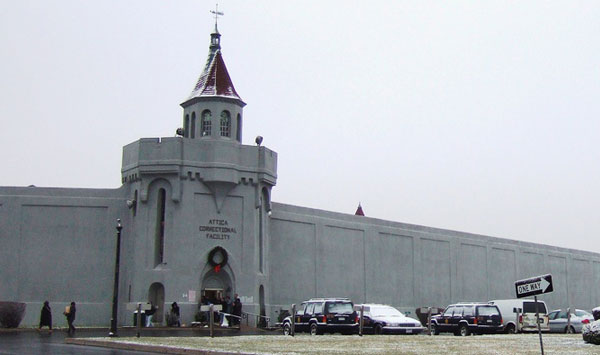
Attica (photo: Wikimedia Commons)
Democrats Bernie Sanders and Elizabeth Warren are widely known as the most liberal lawmakers vying to be the party’s presidential nominee in 2020. Both believe in healthcare, higher education, and childcare for all. They often cite that the country lags behind most other countries of the world in areas of maternity health, infant mortality, economic and wealth inequality, and many other societal measures of health and well-being. However, as far as international standards go, Warren and Sanders are both out of touch in their belief in permanent punishment and life imprisonment in the U.S. criminal justice system.
In June 2019, the New York Times interviewed Sanders, Warren, and the slew of other Democratic presidential candidates running at the time about their stances across many foreign policy and domestic issues, including the death penalty. Just about all of the candidates interviewed affirmed that they opposed the death penalty. Warren and Sanders took their stances a step further, adding that they believed people should be locked up forever as an alternative to the death penalty.
“I also oppose [the death penalty] because I think that people who have committed truly heinous crimes should die in prison, suffering for the rest of their lives,” emphasized Warren. Sanders echoed Warren in his reply by saying, “You have people who should spend the rest of their lives behind bars…” Sanders continued his anti-death penalty stance by saying, “part of the need for real criminal justice reform is for the United States to do what virtually every other major country on earth is doing.”
If Sanders and Warren want to continue to separate themselves from the Democratic presidential pack, then they should look to do what just about every major country on earth is doing and begin to unravel, not reinforce, life imprisonment. They should also examine the historical reality that the people condemned to a life of suffering and death by incarceration in the United States are disproportionately People of Color.
While it’s common knowledge that the United States has roughly 5 percent of the world’s population and 25 percent of the world’s incarcerated, fewer people know that 40 percent of all people on the planet serving a life sentence are behind bars in the U.S. Today, there are more than 206,000 people serving a life sentence in U.S. state and federal prisons—more than the total number of people in all U.S. prisons in 1972. Unsurprisingly, the large majority are black and Latino people. I was one of them.
In 1980, I was convicted of bank robbery and attempted murder of a New York City police sergeant. For the next 38 years, I served a life sentence and met countless others who were also sanctioned to life and death behind bars. I saw firsthand how life imprisonment ripped hope from people’s souls, permanently separated families, and destabilized entire communities, particularly communities of color. I witnessed my fellow lifers take their last breaths in prison cells and hospice beds, grow confused with dementia about why they were in prison in the first place, and age years and decades faster than most people in the outside world.
In January 2018, I was finally released from prison. The day I walked out of prison was the happiest day of my life. It was a day I started to suspect would never come for me.
Over the years some of my closest friends, men who were my mentors, others I had mentored, passed away behind bars. We shared decades of our lives helping each other confront the thinking that led to our incarceration and developing and facilitating the most comprehensive in-prison therapeutic programs that helped to completely change our behavior. We created victim awareness workshops and seminars to develop insight into the harm our crimes inflicted on innocent people. We took full responsibility for rehabilitating ourselves and empowering others with life-affirming principles and values, and a sense of community.
As my brother drove me past the prison grounds I thought about the men I was leaving behind, men who should have been walking out of the prison gates with me. Instead, many will likely die in prison.
When U.S. elected leaders talk about who should suffer and die in prison, they’re talking about men I personally know, men and women who for decades have helped entire generations of younger people transform their lives and who often pose no risk to public safety. Instead, they would enhance the safety of communities if given the chance to return home.
Formerly incarcerated people are often the only ones willing and able to reach out to at-risk young adults who are otherwise abandoned and neglected by society. We give them a vision of a future that does not include gangs, violence, and crime. Such men and women are the reason why I am the man I am today. They are the reason why formerly incarcerated people today serve as credible messengers, violence interrupters, and street counselors. They have helped their peers develop a greater sense of community and civic responsibility than most people who have never been incarcerated.
For these reasons and more, there is a growing national movement working against the sentiments expressed by Sanders and Warren. A movement founded on the fundamental principle that every incarcerated person has the potential for genuine transformation. Death by incarceration sentences are inhumane and rooted in the legacy of racism. They also don’t make us safer.
Decades of research has proven that life imprisonment does not promote public safety, deter crime, or meet the many needs of victims and survivors of interpersonal violence. Further, those serving life sentences are least likely to commit another crime or return to prison upon release as they grow old behind bars. This is even true for people convicted of murder and other forms of serious violence.
The rest of the world realizes these truths, and lawmakers in some states have started to realize them too. In New York for instance, lawmakers are working to pass a bill that would allow the State Board of Parole to give individualized case reviews and assessments for release to people in prison who are age 55 and older and have served 15 or more years. The governor of Virginia recently proposed a similar elder parole policy, while legislators in Pennsylvania, Massachusetts, and Washington State have proposed an end to life without parole sentences.
While there is no one clear way to end prison sentences that amount to permanently punishing people and families, there is a growing understanding that something must be done. Warren, Sanders, and the other Democrats seeking to pave a progressive path to being the next Democratic nominee for president should get on board.
***
Jose Saldana is the Director of the Release Aging People in Prison Campaign, a community organizing and advocacy campaign that works to reform long and life prison sentences and promote racial justice. On Twitter @RAPPcampaign.
***
Have an op-ed idea or submission for Gotham Gazette? Email This email address is being protected from spambots. You need JavaScript enabled to view it.
Empowering Communities to Investigate Potentially Toxic Development
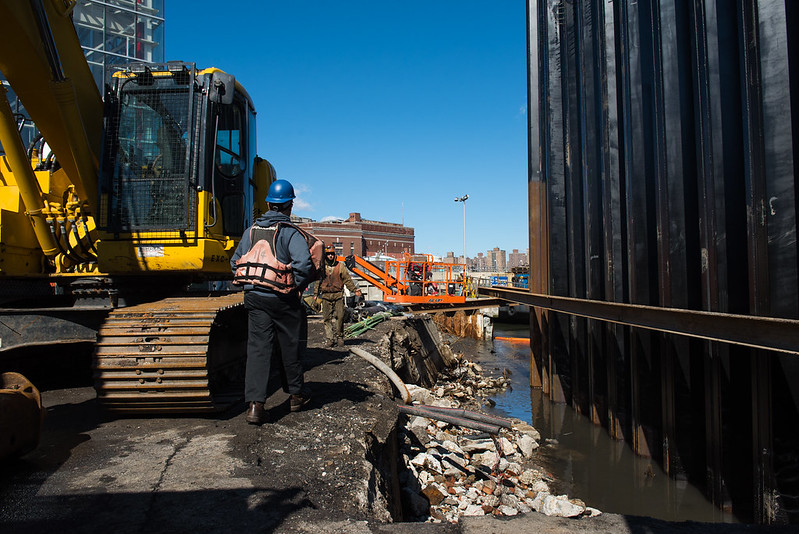
(photo: Edwin J. Torres/Mayoral Photo Office)
Without the network of parents that I have met at my daughter’s school in the historic South Street Seaport, I might never have heard about a real estate developer’s purchase of a parking lot directly across the street that was once the site of the largest thermometer factory complex in the country.
This parking lot is located at 250 Water Street and sits adjacent to the entrances of PS 343 Peck Slip and the Blue School, which is another school that serves pre-kindergarten through fifth-grade children.
I wouldn’t have given the lot a second thought, until a parent told me that the developer – the Howard Hughes Corporation – applied the site to the New York State Department of Environmental Conservation’s Brownfield Cleanup Program.
The words “Brownfield Cleanup” immediately brought to mind nuclear waste sites and decommissioned oil fields, making me question for the first time what was actually under that parking lot.
Alongside other parents and community members, our research uncovered a startling fact: the parking lot at 250 Water Street was the location of several thermometer factories. At one point, this was the largest thermometer factory complex in the entire country. Factories that allowed harmful mercury to seep into the topsoil due to lax regulations when they were in operation. Right now, the parking lot “caps” the mercury, protecting the community from harm, we have been told by state officials. Without this cap, toxic chemicals would be released into the community.
Developers favor the Brownfield Cleanup Program because it releases them from liability if contamination spreads to neighboring sites – in this case like my daughter’s school. If such contamination occurs with a brownfield site, the state assumes liability. And of course, the developer also receives considerable tax credits for using a BCP site. Given past stories of government remediation of toxic sites, this all gives us no comfort.
Understanding that environmental remediation is too expensive for the city or state to do on its own, it’s up to private developers to fund the cleanup. This includes private developers having to pay for their own environmental engineering firm to provide site analysis to include in their application for NYSDEC’s consideration.
I have no doubt that developers would like to prevent young children from getting sick. But I also know that as profit-maximizing entities, their incentives are not necessarily aligned to take the measures needed to protect a community if it costs them more time and money in the short-run.
The NYSDEC does provide a Technical Assistance Grant (TAG) of $50,000 for communities to do their own research – money that could be used to hire an environmental engineer or a lawyer to represent the community – but a TAG can only be applied for once the scope of remediation is already determined, giving the community no power to protect itself. Also, a TAG must be deemed necessary by both the NYSDEC and the private corporation (a law that must be amended).
In our own community fight, as the current assemblywoman was unable to do so, I worked with the Manhattan Borough President’s office to help secure $50,000 of funding from the private real estate developer at 250 Water Street. The funding has been used to hire a physical geologist as an independent community monitor, who has already fundamentally altered the course of the development. Most communities aren’t as lucky to be able to obtain this type of support but deserve the right to be protected.
Our state government in Albany should amend New York State’s Environmental Conservation Law to allow communities to apply for the Technical Assistance Grant as soon as a project is approved to the Brownfield Cleanup Program – not after the Remedial Investigation Work Plan (RIWP) is concluded. Lawmakers can close this ‘developers first, communities last’ provision by amending Article 27, Title 14, Section 27-1417 of the Environmental Conservation Law.
In New York City alone, there are over 200 brownfield cleanup sites currently active. Where are these sites predominantly located? In working class communities like Chinatown, the Lower East Side, Morningside Heights, and East New York. Amending Environmental Conservation Law in this manner would be a clear victory for environmental justice.
No one should tolerate their children or neighbors being exposed to life-threatening toxins, and we deserve elected officials who will fight to protect their constituents, not sell them out to corporations.
***
Grace Lee is the founder of Children First, a parent-led activist group fighting for the safe cleanup of a toxic site located in the South Street Seaport. She is a candidate for the New York State Assembly, 65th district. On Twitter @graceleefornyc.
***
Have an op-ed idea or submission for Gotham Gazette? Email This email address is being protected from spambots. You need JavaScript enabled to view it.
Cuomo’s Cannabis Bill Locks Out Farmers and Preserves Illegal Market in New York

(photo: @nysmallfarma)
As a state government ends the prohibition of cannabis, it can choose to regulate so as to create an industry that favors industrially produced cannabis from large national players and/or it can choose to create a small-scale local cannabis industry. As we’ve now witnessed in Canada, the industrial cannabis industry sacrifices quality for quantity, producing mediocre expensive cannabis, grown at great threat to our planet due to the massive amount of greenhouse gas emissions from indoor cultivation. And as Canada’s example shows, the illegal market will thus continue to flourish.
The only way New York will end the illegal market is if it creates a competitive product. Artisanal craft cannabis, grown under the sun by farmers who know how to produce regenerative high-quality cannabis without synthetic chemicals, is that product. And yet Governor Cuomo’s new bill to legalize adult-use cannabis effectively excludes farmers from growing cannabis.
We at NY Small FarmA, representing the interests of small farmers and those who wish to purchase the healthy, artisanal strains regenerative farmers can produce, were hoping the governor might lead the way in creating this small cultivation and manufacturing industry as he so proudly did for craft breweries.
“New York's craft beverage industry is booming...we have seen significant growth in the number of manufacturers supporting our local farms and spurring job creation across the Empire State,” Cuomo announced in 2018, having just prior proclaimed a record number of breweries in the state he said were “creating jobs, driving tourism, helping our local farms, and instilling pride in every corner of this great state.”
But the bill the governor recently put out as part of his 2020 agenda not only fails to support a craft farm cannabis industry, it makes it impossible for farmers to grow in New York! By failing to recognize cannabis as an agricultural crop and failing to provide the same support the governor provided when recognizing cannabis hemp as an agricultural crop, the governor’s bill will result in the exclusion of farmers from this new industry. This is true because he is not proposing a change to the agriculture and markets law.
The governor knows how to support an agricultural crop when he wants to. He just announced up to $10 million in funding to advance hemp research and economic development opportunities for hemp businesses. When cannabis hemp was legalized in New York, it was expressly recognized as an agricultural crop. Hemp is also the exact same cannabis plant as the plant we all know as marijuana. The only difference between the two is the amount of THC (Tetrahydrocannabinol).
Rather than support what could be a huge revitalization of farming communities, the governor’s bill is a gift to large out-of-state businesses. Adding insult to injury, this bill will fail to produce the tax revenues the governor is counting on because his plan will only fuel the existing illegal cannabis market in New York.
There is still time to urge the governor to amend his bill, incorporating the statutory provisions laid out in NY Small FarmA’s platform. If this bill passes without these provisions, New Yorkers’ only options will be to spend more for inferior quality, pesticide-laden cannabis or continue to find less expensive, higher quality cannabis illegally. There will be no option to purchase healthy, pure regeneratively grown, pesticide-free cannabis, unless you know a farmer you trust and are willing to risk the criminal consequences. This is not how prohibition should end.
***
Andi Novick, Esq., is founder and president of New York Small Farm Alliance of Cannabis Growers & Supporters (NY Small FarmA). On Twitter @nysmallfarma.
***
Have an op-ed idea or submission for Gotham Gazette? Email This email address is being protected from spambots. You need JavaScript enabled to view it.
Campaign Finance Reform is Good, Term Limits and Outside Income Cap Must Come Next
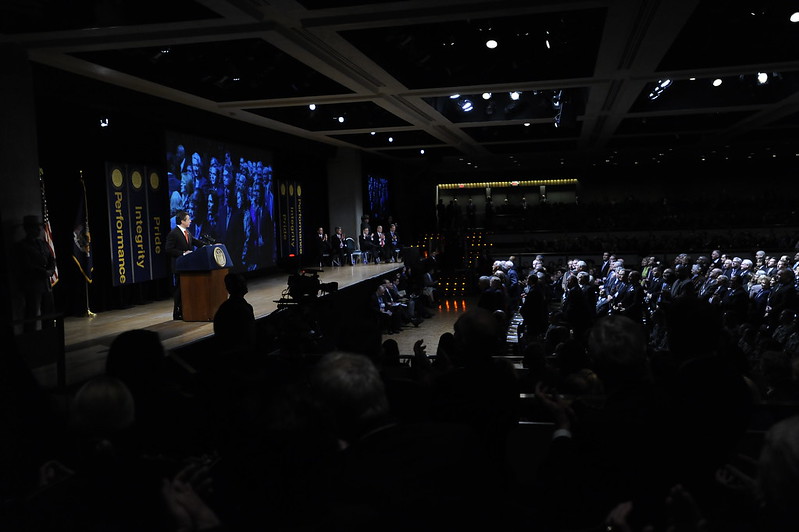
(photo: Governor's Office)
If you have ever given money to a political candidate, you’ve probably received a follow-up email asking you to “rush $3 today to help us reach our goal” or “send in $10 now to show we’re here to win.” I’ve sent quite a few of these emails myself, and I don’t think I would’ve raised more money in a single filing period than any candidate for New York State Assembly ever has if I didn’t. But trust me when I tell you that sending these emails is the worst part of my job as a candidate.
I’m running to unseat my local New York State Assembly member, Dan Quart, on the east side of Manhattan. It was always going to be an uphill campaign because he had raised over $739,000 when we started. When we launched our campaign, I was dismissed by political insiders who said I’d never be able to compete with my opponent’s “prolific” fundraising. I decided to run because I believed my message of bringing a new generation of leadership to Albany would resonate with the people in my district.
It did. And we are doing more than just competing. We made an effort to be present in the community and we earned the support of thousands of residents. We sent lots of annoying emails, raised that record amount of money, and got attacked for it by the same people who said we could never raise it. Now we're going to use it to compete in an electoral system designed by incumbents to deter primary challengers like me.
The maximum individual contribution in my race—where roughly 10,000 people will vote in the June Democratic primary—is $4,700. That’s 68% more than what you can give to someone running for President of the United States. In New York, high contribution limits mean that incumbents can leverage name recognition and pre-established donor networks to outraise primary challengers or keep them out of the race altogether. My district, for example, hasn’t had a contested Democratic primary for about as long as I’ve been alive.
A new system of public campaign financing set to take effect in 2024 would reduce contribution limits to campaigns for state offices and match donations under $250 with at least six times as much money in public funds. Lower contribution limits and a matching program for small donations should mean more competitive primaries across the state and more new voices in Albany. That’s great, but money’s corrosive effect on our politics isn’t just a function of our broken campaign finance system.
In Albany, New York State legislators now earn $110,000 from taxpayers for what is still considered a part-time job and collect outside income as they wish. My opponent, for example, collected at least $100,000 in outside income in 2018 alone. New Yorkers deserve representatives whose financial interests don’t conflict with their obligations of public service. That’s why I’ve pledged to serve my constituents full-time and forego private sector opportunities. But individual pledges aren’t enough. We need real reform that ensures our representatives have only one boss: the people.
Unfortunately, efforts to regulate salary and limit outside income have fallen apart. A commission co-created by Governor Cuomo and the state Legislature recommended a three-phase salary hike for legislators—rising to $130,000 by 2021—and a cap on outside income totaling 15% of legislators’ base salary. Despite the fact that the cap was based on limitations currently in place for members of Congress, New York courts ruled against it. Legislators could pass a bill designed to limit outside income right now, but if you’re familiar with New York’s corruption problems, you’re probably not holding your breath.
New Yorkers are used to politicians using public office for personal gain. That’s why young people running to replace them should make ethical leadership one of our guiding values. It’s why I support term limits for all elected offices and a ban on outside income for all legislators. Because if we’re going to change how we run for office, we should change how we’re compensated when we win too. My generation is just getting started in government, but before we’re done we can get money out of politics, politicians who work for the people, and fundraising emails out of your inbox.
***
Cameron Koffman is a Democrat running for New York State Assembly in Manhattan’s 73rd District. On Twitter @Cameron2020NY.
***
Have an op-ed idea or submission for Gotham Gazette? Email This email address is being protected from spambots. You need JavaScript enabled to view it.




